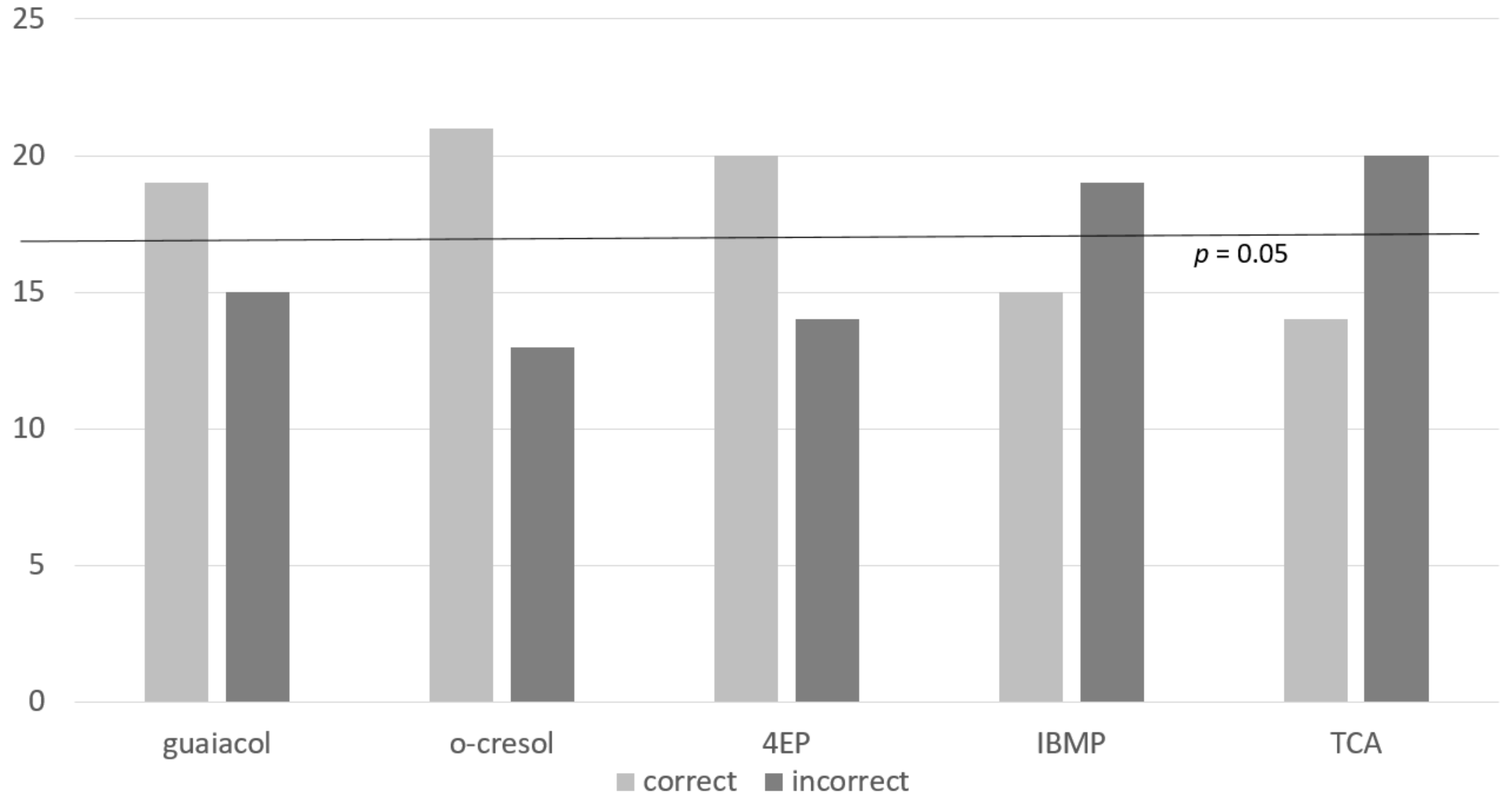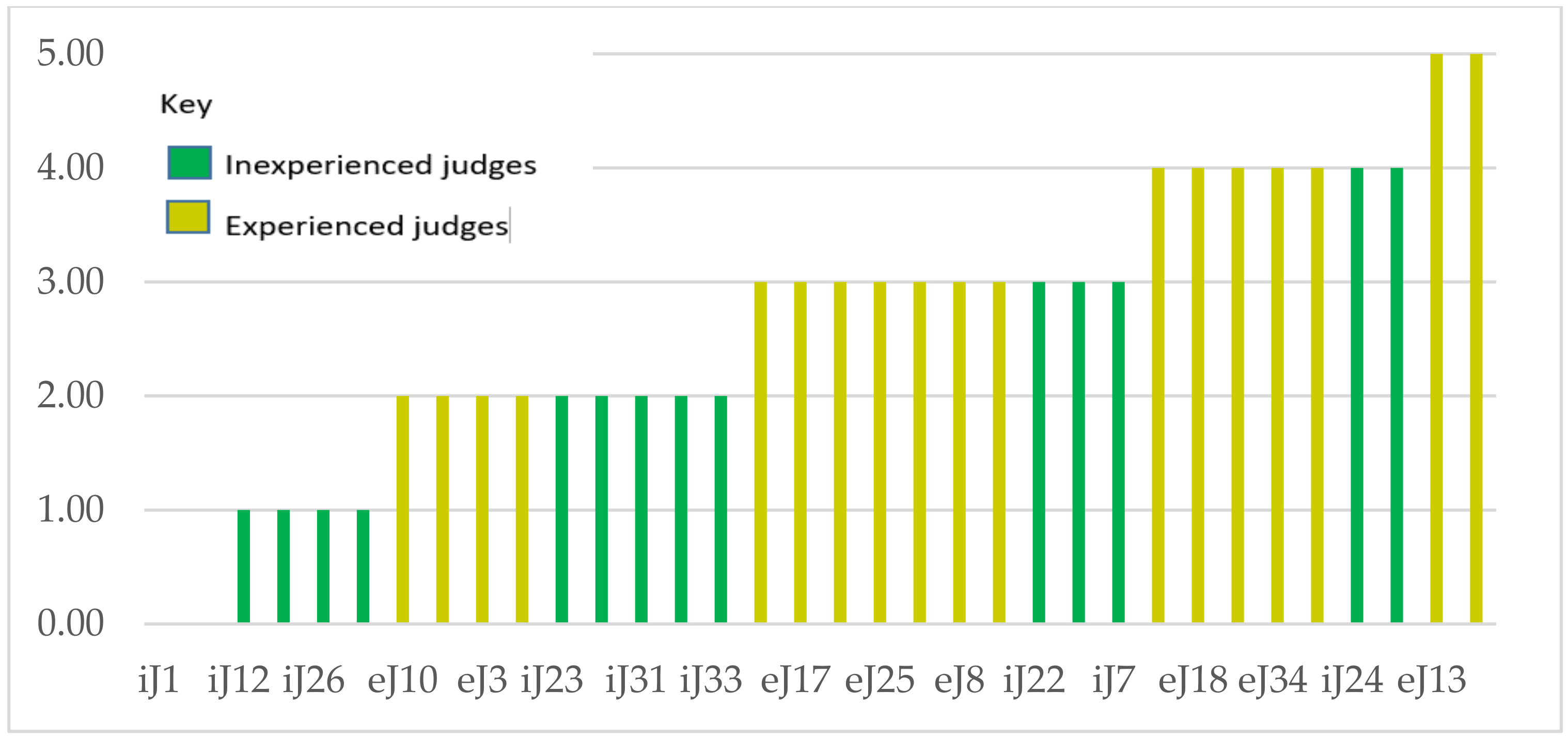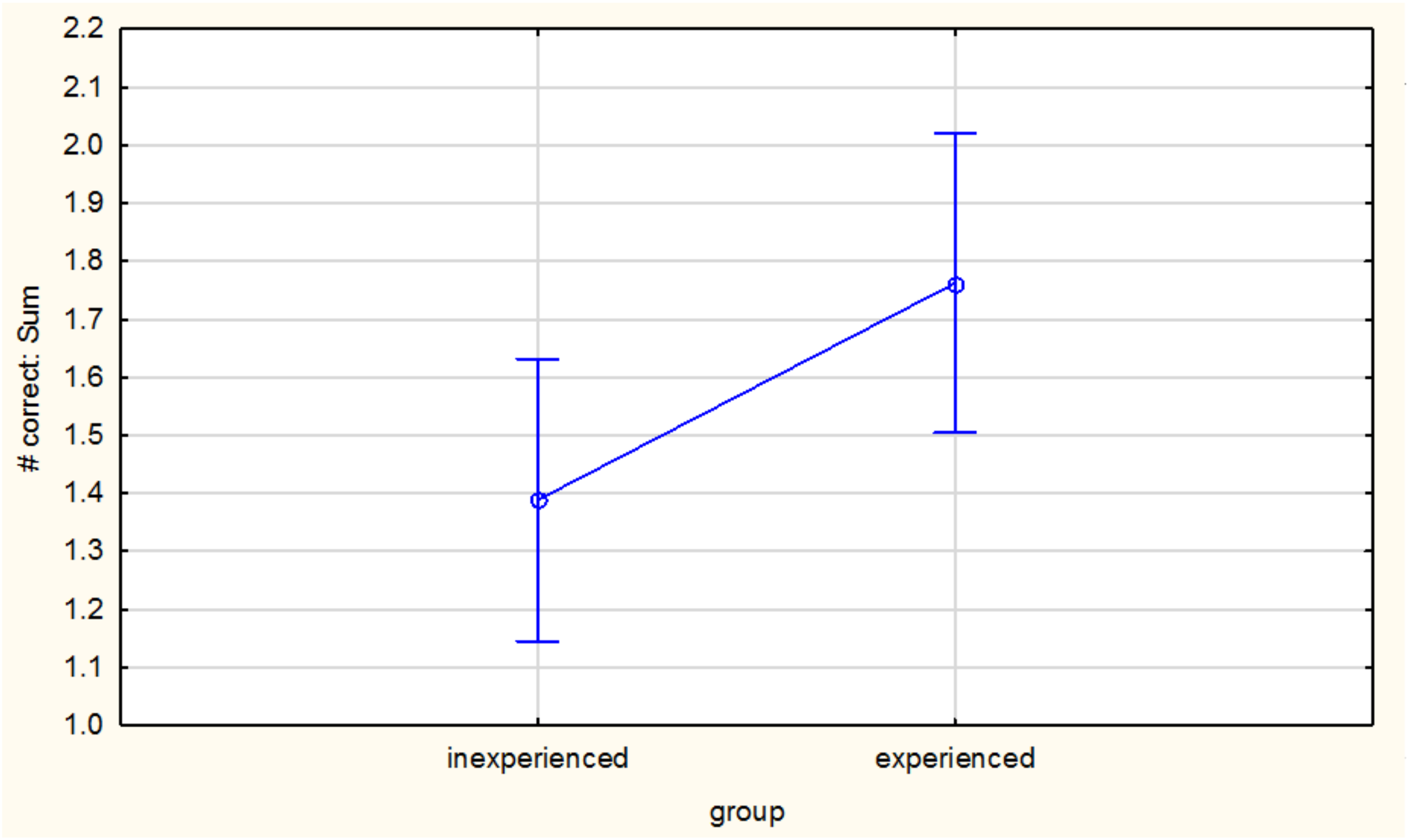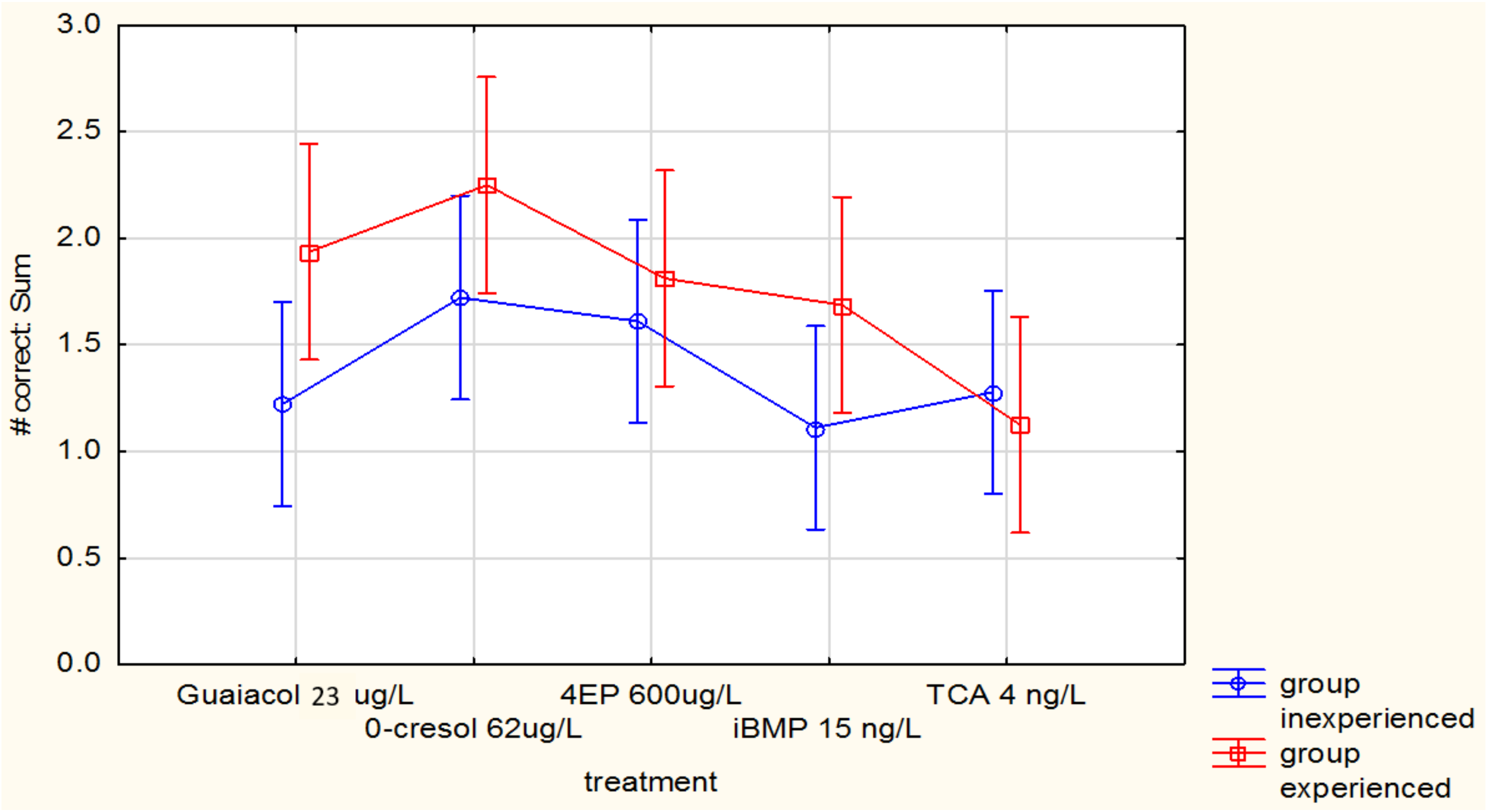Testing the Sensitivity of Potential Panelists for Wine Taint Compounds Using a Simplified Sensory Strategy
Abstract
1. Introduction
2. Materials and Methods
2.1. Base Wine
2.2. Preparation of Spiked Wine Samples
2.3. Panel Selection
2.4. Sensory Testing
2.5. Data Analysis
3. Results
3.1. Investigation of Odor Detection Thresholds
3.2. Differences in Frequency of Correct Detection between Compounds by Panelists
3.3. The Impact of Previous Training or Exposure on Judge Sensitivity
4. Conclusions
Author Contributions
Funding
Acknowledgments
Conflicts of Interest
References
- Perry, D.M.; Hayes, J.E. Effects of matrix composition on detection threshold estimates for methyl anthranilate and 2-Aminoacetophenone. Foods 2016, 5, E35. [Google Scholar] [CrossRef] [PubMed]
- Lawless, H.T.; Heymann, H. Sensory Evaluation of Foods: Principles & Practices, 2nd ed.; Springer Science Business Media LLC: New York, NY, USA, 2010. [Google Scholar]
- American Society for Testing and Materials ASTM E1432-04 (2011). Standard Practice for Defining and Calculating Individual and Group Sensory Thresholds from Forced-Choice Data Sets of Intermediate Size. Available online: https://www.astm.org/Standards/E1432.htm (accessed on 25 August 2018).
- Martineau, B.; Acree, T.E.; Henick-Kling, T. Effect of wine type on the detection threshold for diacetyl. Food Res. Int. 1995, 28, 139–143. [Google Scholar] [CrossRef]
- Brown, K.; Maclean, C.M.; Robinette, R.R. The distribution of the sensitivity to chemical odors in man. Hum. Biol. 1968, 40, 456–472. [Google Scholar] [CrossRef] [PubMed]
- Pickering, G.J.; Karthik, A.; Inglis, D.; Sears, M.; Ker, K. Determination of Ortho- and Retronasal Detection Thresholds for 2-Isopropyl-3-Methoxypyrazine in Wine. J. Food Sci. 2007, 72, S468–S472. [Google Scholar] [CrossRef] [PubMed]
- Wood, C.; Siebert, T.E.; Parker, M.; Capone, D.L.; Elsey, G.M.; Pollnitz, A.P.; Eggers, M.; Meier, M.; Vössing, T.; Widder, S.; et al. From wine to pepper: Rotundone, an obscure sesquiterpene, is a potent spicy aroma compound. J. Agric. Food Chem. 2008, 56, 3738–3744. [Google Scholar] [CrossRef] [PubMed]
- American Society for Testing and Materials ASTM E679-04(2011). Standard Practice for Determination of Odor and Taste Thresholds by a Forced-Choice Ascending Concentration Series Method of Limits. Available online: https://www.astm.org/Standards/E679.htm (accessed on 10 May 2018).
- Mazzoleni, V.; Maggi, L. Effect of wine style on the perception of 2,4,6-trichloroanisole, a compound related to cork taint in wine. Food Res. Int. 2007, 40, 694–699. [Google Scholar] [CrossRef]
- Yang, W.; Li, W.; Liu, B. Odour prediction model using odour activity value from pharmaceutical industry. Austrian Contrib. Vet. Epidemiol. 2015, 8, 51–60. [Google Scholar]
- Villamor, R.R.; Ross, C.F. Wine matrix compounds affect perception of wine aromas. Annu. Rev. Food Sci. Technol. 2013, 4, 1–20. [Google Scholar] [CrossRef] [PubMed]
- Lorrain, B.; Tempere, S.; Iturmendi, N.; Moine, V.; De Revel, G.; Teissedre, P.-L. Influence of phenolic compounds on the sensorial perception and volatility of red wine esters in model solution: An insight at the molecular level. Food Chem. 2013, 140, 76–82. [Google Scholar] [CrossRef] [PubMed]
- Lapalus, E. Linking Sensory Attributes to Selected Aroma Compounds in South African Cabernet Sauvignon Wines. Master’s Thesis, Stellenbosch University, Western Cape, South Africa, March 2016. [Google Scholar]
- Tempere, S.; Cuzange, E.; Malak, J.; Bougeant, J.C.; De Revel, G.; Sicard, G. The training level of experts influences their detection thresholds for key wine compounds. Chemosens. Percept. 2011, 4, 99–115. [Google Scholar] [CrossRef]
- Larcher, R.; Nicolini, G.; Bertoldi, D.; Nardin, T. Determination of 4-ethylcatechol in wine by high-performance liquid chromatography–coulometric electrochemical array detection. Anal. Chim. Acta 2008, 609, 235–240. [Google Scholar] [CrossRef] [PubMed]
- Curtin, C.; Bramley, B.; Cowey, G.; Holdstock, M.; Lattey, K.; Coulter, A.; Henschke, P.; Francis, L.; Godden, P. Sensory perception of Brett and relationship to consumer preference. In Proceedings of the 13th Australian Wine Industry Technical Conference, Adelaide, Australia, 27 July–2 August 2007; pp. 207–211. [Google Scholar]
- Bearak, B. A Whiff of Controversy and South African Wines—The New York Times. Available online: https://www.nytimes.com/2009/06/29/world/africa/29stellenbosch.html (accessed on 26 June 2018).
- Botha, J.J. Sensory, Chemical and Consumer Analysis of Brettanomyces Spoilage in South African Wines. Master’s Thesis, Stellenbosch University, Western Cape, South Africa, March 2010. [Google Scholar]
- Hammond, C.E. South African Wine under Fire. Available online: http://www.carolynevanshammond.com/blog/2015/10/12/south-african-wine-under-fire-1 (accessed on 26 June 2018).
- Van Eeden, P.R. Chemical, Sensory and Consumer Analysis of Cork Taint in South African Wines. Master’s Thesis, Stellenbosch University, Western Cape, South Africa, March 2009. [Google Scholar]
- Parker, M.; Osidacz, P.; Baldock, G.A.; Hayasaka, Y.; Black, C.A.; Pardon, K.H.; Jeffery, D.W.; Geue, J.P.; Herderich, M.J.; Francis, I.L. Contribution of several volatile phenols and their glycoconjugates to smoke-related sensory properties of red wine. J. Agric. Food Chem. 2012, 60, 2629–2637. [Google Scholar] [CrossRef] [PubMed]
- Parker, B.M.; Baldock, G.; Hayasaka, Y.; Mayr, C.; Williamson, P.; Francis, I.L.; Krstic, M.; Herderich, M.; Johnson, D. Seeing through smoke. Wine Vitic. J. 2013, 28, 42–46. [Google Scholar]
- Chatonnet, P.; Dubourdie, D.; Boidron, J.-N.; Pons, M. The origin of ethylphenols in wines. J. Sci. Food Agric. 1992, 60, 165–178. [Google Scholar] [CrossRef]
- Roujou de Boubée, D.; Van Leeuwen, C.; Dubourdieu, D. Organoleptic impact of 2-methoxy-3-isobutylpyrazine on red Bordeaux and Loire wines. Effect of environmental conditions on concentrations in grapes during ripening. J. Agric. Food Chem. 2000, 48, 4830–4834. [Google Scholar] [CrossRef] [PubMed]
- Prescott, J.; Norris, L.; Kunst, M.; Kim, S. Estimating a “consumer rejection threshold” for cork taint in white wine. Food Qual. Prefer. 2005, 16, 345–349. [Google Scholar] [CrossRef]
- Boidron, J.N.; Chatonnet, P.; Pons, M. Influence du bois sur certaines substances odorantes des vins. Connaiss. La Vigne Du Vin 1988, 22, 275–294. [Google Scholar] [CrossRef]
- Kennison, K.R.; Wilkinson, K.L.; Williams, H.G.; Smith, J.H.; Gibberd, M.R. Smoke-derived taint in wine: Effect of postharvest smoke exposure of grapes on the chemical composition and sensory characteristics of wine. J. Agric. Food Chem. 2007, 55, 10897–10901. [Google Scholar] [CrossRef] [PubMed]
- Spillman, P.J.; Iland, P.G.; Sefton, M.A. Accumulation of volatile oak compounds in a model wine stored in American and Limousin oak barrels. Aust. J. Grape Wine Res. 1998, 4, 67–73. [Google Scholar] [CrossRef]
- Escudero, A.; Campo, E.; Fariña, L.; Cacho, J.; Ferreira, V. Analytical characterization of the aroma of five premium red wines. Insights into the role of odor families and the concept of fruitiness of wines. J. Agric. Food Chem. 2007. [Google Scholar] [CrossRef] [PubMed]
- Allen, M.S.; Lacey, M.J.; Boyd, S.J. Existence of different origins for Methoxypyrazines of grapes and wines. In Biotechnology for Improved Foods and Flavors; Takeoka, G.R., Teranishi, R., Williams, P.J., Kobayashi, A., Eds.; American Chemical Society: Washington, DC, USA, 1996; pp. 220–227. [Google Scholar]
- PubChem. 2-Isobutyl-3-methoxypyrazine|C9H14N2O—PubChem. Available online: https://pubchem.ncbi.nlm.nih.gov/compound/2-isobutyl-3-methoxypyrazine#section=Top (accessed on 19 June 2018).
- Shibamoto, T. Odor threshold of some pyrazines. J. Food Sci. 1986, 51, 1098–1099. [Google Scholar] [CrossRef]
- Tempere, S.; Schaaper, M.H.; Cuzange, E.; De Revel, G.; Sicard, G. Masking of several olfactory notes by infra-threshold concentrations of 2,4,6-trichloroanisole. Chemosens. Percept. 2017, 10, 69–80. [Google Scholar] [CrossRef]
- Hein, K.; Ebeler, S.; Heymann, H. Perception of fruity and vegetative aromas in red wine. J. Sens. Stud. 2009, 24, 441–455. [Google Scholar] [CrossRef]
- Cravero, M.C.; Bonello, F.; Del Pazo Alvarez, M.C.; Tsolakis, C.; Borsa, D. The sensory evaluation of 2,4,6-trichloroanisole in wines. J. Inst. Brew. 2015, 121, 411–417. [Google Scholar] [CrossRef]
- Campo, E.; Ferreira, V.; Escudero, A.; Cacho, J. Prediction of the wine sensory properties related to grape variety from dynamic-headspace gas chromatography−olfactometry data. J. Agric. Food Chem. 2005, 53, 5682–5690. [Google Scholar] [CrossRef] [PubMed]
- Petrozziello, M.; Asproudi, A.; Guaita, M.; Borsa, D.; Motta, S.; Panero, L.; Bosso, A. Influence of the matrix composition on the volatility and sensory perception of 4-ethylphenol and 4-ethylguaiacol in model wine solutions. Food Chem. 2014, 149, 197–202. [Google Scholar] [CrossRef] [PubMed]
- Kim, D. Understanding the Effects of Wine Matrix Compounds on the Perception of Aromatic Wine Faults. Ph.D. Thesis, University of Guelph, Guelph, ON, Canada, December 2016. [Google Scholar]
- Chrea, C.; Valentin, D.; Sulmont-Ross, C.; Ly Mai, H.; Hoang Nguyen, D.; Abdi, H. Culture and odor categorization: Agreement between cultures depends upon the odors. Food Qual. Prefer. 2004, 15, 669–679. [Google Scholar] [CrossRef]
- Takeuchi, H.; Kato, H.; Kurahashi, T. 2,4,6-Trichloroanisole is a potent suppressor of olfactory signal transduction. Proc. Natl. Acad. Sci. USA 2013, 110, 16235–16240. [Google Scholar] [CrossRef] [PubMed]
- Kaeppler, K.; Mueller, F. Odor classification: A review of factors influencing perception—Based odor arrangements. Chem. Sens. 2013, 38, 189–209. [Google Scholar] [CrossRef] [PubMed]
- Wilson, C.L. Chemical Evaluation and Sensory Relevance of Thiols in South African Chenin Blanc Wines. Master’s Thesis, Stellenbosch University, Western Cape, South Africa, March 2017. [Google Scholar]
- De Vries, C.J.; Mokwena, L.M.; Buica, A.; McKay, M. Determination of volatile phenol in Cabernet Sauvignon wines made from smoke-affected grapes, by using HS-SPME GC-MS. S. Afr. J. Enol. Vitic. 2016, 37, 15–21. [Google Scholar] [CrossRef]
- Roessler, E.B.; Pangborn, R.M.; Sidel, J.L.; Stone, H. Expanded statistical tables for estimating significance in paired-preference, paired-difference, duo-trio and triangle tests. J. Food Sci. 1978, 43, 940–943. [Google Scholar] [CrossRef]
- Van Wyngaard, E.; Brand, J.; Jacobson, D.; Du Toit, W.J. Sensory interaction between 3-mercaptohexan-1-ol and 2-isobutyl-3-methoxypyrazine in dearomatised Sauvignon Blanc wine. Aust. J. Grape Wine Res. 2014, 20, 178–185. [Google Scholar] [CrossRef]
- Sefton, M.A.; Simpson, R.F. Compounds causing cork taint and the factors affecting their transfer from natural cork closures to wine—A review. Aust. J. Grape Wine Res. 2005, 11, 226–240. [Google Scholar] [CrossRef]
- Hanley, J.A.; Negassa, A.; DeB Edwardes, M.D.; Forrester, J.E. Statistical analysis of correlated data using generalized estimating equations: An orientation. Am. J. Epidemiol. 2003, 157, 364–375. [Google Scholar] [CrossRef] [PubMed]
- Noble, A.C.; Arnold, R.A.; Buechsenstein, J.; Leach, E.J.; Schmidt, J.O.; Stern, P.M. Modification of a standardized system of wine aroma terminology. Am. J. Enol. Vitic. 1987, 38, 143–146. [Google Scholar]
- Curtis, V.; De Barra, M.; Aunger, R. Disgust as an adaptive system for disease avoidance behaviour. Philos. Trans. R. Soc. Lond. B Biol. Sci. 2011, 366, 389–401. [Google Scholar] [CrossRef] [PubMed]
- Tempere, S.; Cuzange, E.; Bougeant, J.C.; De Revel, G.; Sicard, G. Explicit sensory training improves the olfactory sensitivity of wine experts. Chemosens. Percept. 2012, 5, 205–213. [Google Scholar] [CrossRef]




| Compound | Odor Detection Threshold | Descriptors | Reference |
|---|---|---|---|
| Guaiacol | 23 µg/L | Burnt, smoky, toasty phenolic | [21] |
| o-Cresol | 62 µg/L | Burnt smoky, medicinal, tar | [22] |
| 4EP | 605 µg/L | Leather, bacon, medicinal, horse | [23] |
| IBMP | 15 ng/L | Bell pepper, green, herbaceous | [24] |
| TCA | 4 ng/L | Moldy, musty, damp cardboard | [25] |
| Triangle Test Correlations between Compounds (n = 34) | |||||
|---|---|---|---|---|---|
| Compound 1 | Compound 2 | Pearson | Pearson p | Spearman | Spearman p |
| o-Cresol | 4EP | −0.06 | 0.74 | −0.05 | 0.78 |
| o-Cresol | Guaiacol | −0.13 | 0.46 | −0.10 | 0.56 |
| o-Cresol | IBMP | 0.19 | 0.28 | 0.19 | 0.27 |
| o-Cresol | TCA | 0.06 | 0.75 | 0.04 | 0.82 |
| 4EP | Guaiacol | 0.08 | 0.65 | 0.06 | 0.74 |
| 4EP | IBMP | 0.00 | 0.98 | 0.03 | 0.88 |
| 4EP | TCA | 0.28 | 0.11 | 0.27 | 0.12 |
| Guaiacol | IBMP | 0.24 | 0.17 | 0.24 | 0.17 |
| Guaiacol | TCA | 0.16 | 0.37 | 0.14 | 0.42 |
| IBMP | TCA | 0.01 | 0.96 | 0.02 | 0.91 |
| Comparisons | 1st Mean | 2nd Mean | Mean Diff | p |
|---|---|---|---|---|
| 1-2 | Guaiacol | o-Cresol | −0.41 | 0.09 |
| 1-3 | Guaiacol | 4EP | −0.15 | 0.54 |
| 1-4 | Guaiacol | IBMP | 0.18 | 0.47 |
| 1-5 | Guaiacol | TCA | 0.35 | 0.15 |
| 2-3 | o-Cresol | 4EP | 0.26 | 0.28 |
| 2-4 | o-Cresol | IBMP | 0.59 | 0.02 |
| 2-5 | o-Cresol | TCA | 0.76 | 0.00 |
| 3-4 | 4EP | IBMP | 0.32 | 0.18 |
| 3-5 | 4EP | TCA | 0.50 | 0.04 |
| 4-5 | IBMP | TCA | 0.18 | 0.47 |
© 2018 by the authors. Licensee MDPI, Basel, Switzerland. This article is an open access article distributed under the terms and conditions of the Creative Commons Attribution (CC BY) license (http://creativecommons.org/licenses/by/4.0/).
Share and Cite
McKay, M.; Bauer, F.F.; Panzeri, V.; Buica, A. Testing the Sensitivity of Potential Panelists for Wine Taint Compounds Using a Simplified Sensory Strategy. Foods 2018, 7, 176. https://doi.org/10.3390/foods7110176
McKay M, Bauer FF, Panzeri V, Buica A. Testing the Sensitivity of Potential Panelists for Wine Taint Compounds Using a Simplified Sensory Strategy. Foods. 2018; 7(11):176. https://doi.org/10.3390/foods7110176
Chicago/Turabian StyleMcKay, Marianne, Florian F. Bauer, Valeria Panzeri, and Astrid Buica. 2018. "Testing the Sensitivity of Potential Panelists for Wine Taint Compounds Using a Simplified Sensory Strategy" Foods 7, no. 11: 176. https://doi.org/10.3390/foods7110176
APA StyleMcKay, M., Bauer, F. F., Panzeri, V., & Buica, A. (2018). Testing the Sensitivity of Potential Panelists for Wine Taint Compounds Using a Simplified Sensory Strategy. Foods, 7(11), 176. https://doi.org/10.3390/foods7110176







